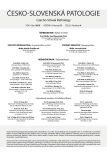Recurrence of primary diseases after liver transplantation
Authors:
Víta Žampachová 1; Eva Honsová 2
Authors‘ workplace:
I. patologicko-anatomický ústav FN u sv. Anny v Brně a LF MU
1; Pracoviště klinické a transplantační patologie, Transplantcentrum IKEM, Praha
2
Published in:
Čes.-slov. Patol., 51, 2015, No. 4, p. 170-174
Category:
Reviews Article
Overview
A majority of primary diseases for which orthotopic liver transplantation is carried out may recur in the liver allograft, mostly in adults. As the indication criteria, transplantation surgery and post-transplantation care improve, the patient’s survival lengthens as well, leading to concurrently increasing incidence as well as an increase in the relevance of recurrent diseases, which are the most significant cause of late liver graft dysfunction. The frequency, clinical consequences and therapeutic options of different disease recurrence vary considerably. Even recently the worst prognosis has been associated with hepatitis C for 100% reinfection, this situation is beginning to change with new oral antiviral drugs, as has already been successfully done with hepatitis B. Among immune-mediated disorders, primary biliary cirrhosis recurrence affects 30 – 50% of transplant patients, albeit with mild consequences. Graft loss and subsequent necessity of retransplantation are observed in almost 10% of patients with primary sclerosing cholangitis recurrence. 30% prevalence rates for autoimmune hepatitis recurrence are reported but the frequency of graft loss has declined considerably due to maintenance of corticosteroid therapy. Excessive relapse of alcohol consumption in patients with liver transplant for alcoholic liver disease leads most commonly to extrahepatic complications. Recurrent non-alcoholic steatohepatitis is rarely connected with graft loss in 5 – 10 years after transplantation. The diagnosis of a recurrent disease following liver transplantation is to a large extent based on histopathological features. In the differential diagnosis, other causes of graft dysfunction must be excluded.
Keywords:
liver transplantation – recurrence – biopsy
Sources
1. Banff Working Group, Demetris AJ, Adeyi O, et al. Liver biopsy interpretation for causes of late liver allograft dysfunction. Hepatology 2006; 44(2): 489-501.
2. Hübscher SG. What is the long-term outcome of the liver allograft. J Hepatol 2011; 55: 702-717.
3. Demetris AJ. Evolution of hepatitis C virus in liver allografts. Liver Transplantation 2009; 15: S35-S41.
4. Salomao M, Verna EC, Lefkowitch JH et al. Histopathologic distinction between fibrosing cholestatic hepatitis C and biliary obstruction. Am J Surg Pathol 2013; 37(12): 1837-1844.
5. Sperl J, Frankova S, Kieslichova E et al. Urgent liver transplantation for chemotherapy-induced HBV reactivation: a suitable option in patients recently treated for malignant lymphoma. Transplant Proc 2013; 45(7): 2834-2837.
6. Duclos-Vallee J-C, Sebagh M. Recurrence of autoimmune disease, primary sclerosing cholangitis, primary biliary cirrhosis, and autoimmune hepatitis after liver transplantaton. Liver Transpl 2009; 15: S25-S34.
7. Czaja A. Diagnosis, pathogenesis, and treatment of autoimmune hepatitis after liver transplantaton. Dig Dis Sci 2012; 57: 2248-2266.
8. Liberal R, Zen Y, Mieli-Vergani G, Vergani D. Liver Transplantation and Autoimmune Liver Diseases. Liver Transpl 2013; 19: 1065-1077.
9. Carbone M, Neuberger J. Liver transplantation in PBC and PSC: Indication and disease recurrence. Clin Res Hepatol Gastroenterol 2011; 35: 446-454.
10. Gramenzi A, Gitto S, Caputo F et al. Liver transplantation for patients with alcoholic liver disease: An open question. Dig Liver Dis 2011; 43: 843-849.
11. Patil TD, Yerian LM. Evolution of nonalcoholic fatty liver disease recurrence after liver transplantation. Liver Transpl 2012; 18: 1147-1153.
12. El Atrache MM, Abouljoud MS, Divine G, et al. Recurrence of non-alcoholic steatohepatitis and cryptogenic cirrhosis following orthotopic liver transplantation in the context of the metabolic syndrome. Clin Transplant 2012; 26: E505-E512.
Labels
Anatomical pathology Forensic medical examiner ToxicologyArticle was published in
Czecho-Slovak Pathology

2015 Issue 4
Most read in this issue
- Periosteal osteosarcoma - personal experience with five cases
- Transplantations of lungs in the Czech Republic – from the perspective of the pathologist
- Diagnosis of rejection in a transplanted liver
- Surgical techniques of organ transplants
